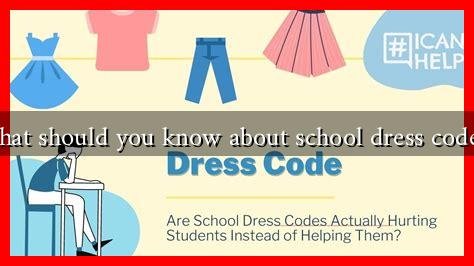-
Table of Contents
What Should You Know About School Dress Codes?
School dress codes have been a topic of debate for decades, influencing not only the way students express themselves but also the overall school environment. Understanding the nuances of dress codes can help students, parents, and educators navigate this complex issue. This article delves into the purpose, benefits, controversies, and best practices surrounding school dress codes.
The Purpose of School Dress Codes
Dress codes are implemented in schools for various reasons, including:
- Promoting a Positive Learning Environment: Dress codes aim to minimize distractions in the classroom, allowing students to focus on their studies.
- Encouraging Equality: By setting standards for attire, schools can reduce socioeconomic disparities that may be highlighted through clothing choices.
- Fostering School Identity: Uniforms or specific dress codes can create a sense of belonging and school pride among students.
Benefits of Dress Codes
Implementing a dress code can yield several benefits for students and the school community:
- Improved Discipline: Schools with dress codes often report better student behavior and discipline.
- Enhanced Safety: Dress codes can help identify outsiders on campus, contributing to a safer school environment.
- Reduced Peer Pressure: A standardized dress code can lessen the pressure on students to wear trendy or expensive clothing.
Controversies Surrounding Dress Codes
Despite their benefits, dress codes are not without controversy. Some common criticisms include:
- Gender Bias: Many dress codes disproportionately target female students, often focusing on their attire more than male students. For example, policies that ban tank tops or short skirts can be seen as unfairly restrictive.
- Suppression of Self-Expression: Critics argue that dress codes limit students’ ability to express their individuality and cultural identity through clothing.
- Inconsistency in Enforcement: Unequal enforcement of dress codes can lead to feelings of injustice among students, particularly if certain styles are deemed acceptable for some but not others.
Case Studies and Statistics
Research has shown mixed results regarding the effectiveness of dress codes.
. A study conducted by the National Center for Education Statistics found that:
- Schools with strict dress codes reported a 10% decrease in disciplinary incidents.
- However, 60% of students felt that dress codes were unfairly enforced, particularly among different genders and ethnicities.
In a notable case in 2018, a high school in Florida faced backlash after a dress code policy was implemented that banned certain hairstyles, which disproportionately affected Black students. This incident sparked a broader conversation about cultural sensitivity in dress codes and led to a reevaluation of the policy.
Best Practices for Implementing Dress Codes
To create an effective and fair dress code, schools should consider the following best practices:
- Involve Stakeholders: Engage students, parents, and teachers in the development of dress code policies to ensure diverse perspectives are considered.
- Focus on Educational Goals: Ensure that the dress code aligns with the school’s mission and educational objectives.
- Be Clear and Specific: Clearly outline what is acceptable and what is not, avoiding vague language that can lead to confusion.
- Regularly Review Policies: Periodically assess the dress code to ensure it remains relevant and fair, adapting to changing societal norms and values.
Conclusion
School dress codes serve a variety of purposes, from promoting discipline to fostering a sense of community. However, they also raise important questions about fairness, self-expression, and cultural sensitivity. By understanding the complexities of dress codes and implementing best practices, schools can create an environment that respects individual expression while maintaining a focus on education. As the conversation around dress codes continues to evolve, it is crucial for all stakeholders to engage in open dialogue to ensure that policies are equitable and effective.
For more information on the impact of dress codes in schools, you can visit Edutopia.





